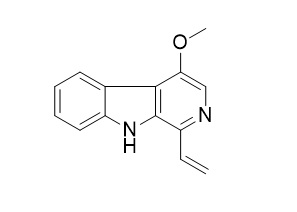1-vinyl-4-dimethoxy-beta-carboline
1-vinyl-4-dimethoxy-beta-carboline is a natural product from Picrasma javanica.
Inquire / Order:
manager@chemfaces.com
Technical Inquiries:
service@chemfaces.com
Tel:
+86-27-84237783
Fax:
+86-27-84254680
Address:
1 Building, No. 83, CheCheng Rd., Wuhan Economic and Technological Development Zone, Wuhan, Hubei 430056, PRC
Providing storage is as stated on the product vial and the vial is kept tightly sealed, the product can be stored for up to
24 months(2-8C).
Wherever possible, you should prepare and use solutions on the same day. However, if you need to make up stock solutions in advance, we recommend that you store the solution as aliquots in tightly sealed vials at -20C. Generally, these will be useable for up to two weeks. Before use, and prior to opening the vial we recommend that you allow your product to equilibrate to room temperature for at least 1 hour.
Need more advice on solubility, usage and handling? Please email to: service@chemfaces.com
The packaging of the product may have turned upside down during transportation, resulting in the natural compounds adhering to the neck or cap of the vial. take the vial out of its packaging and gently shake to let the compounds fall to the bottom of the vial. for liquid products, centrifuge at 200-500 RPM to gather the liquid at the bottom of the vial. try to avoid loss or contamination during handling.
Front Plant Sci.2020, 11:630.
Pharmaceuticals (Basel).2020, 13(10):302.
Revista Brasileira de Farmacognosia2024, 34:1091-1100.
Biochem Biophys Res Commun.2017, 482(4):1095-1101
Horticulturae2021, 7(1),5.
Ajou University2024, 4688116
Sci Rep.2018, 8:15059
Arabian Journal of Chemistry2024, 17(3):105648
Evid Based Complement Alternat Med.2018, 2018:1073509
Korean J. Food Sci. & Technol.2022, 54(2):241-246
Related and Featured Products
Molecules. 2014 Jun 25;19(7):8752-61.
Preparative separation of alkaloids from Picrasma quassioides (D. Don) Benn. by conventional and pH-zone-refining countercurrent chromatography.[Pubmed:
24968331 ]
METHODS AND RESULTS:
Two high-speed countercurrent chromatography (HSCCC) modes were compared by separation of major alkaloids from crude extract of Picrasma quassioides. The conventional HSCCC separation was performed with a two-phase solvent system composed of petroleum ether-ethyl acetate-methanol-water (5:5:4.5:5.5, v/v/v/v) with 200 mg loading. pH-Zone-refining CCC was performed with two-phase solvent system composed of petroleum ether-ethyl acetate-n-butanol-water (3:2:7:9, v/v/v/v) where triethylamine (10 mM) was added to the upper organic stationary phase and hydrochloric acid (5 mM) was added to the lower aqueous phase with 2 g loading. From 2 g of crude extract, 87 mg of 5-methoxycanthin-6-one (a), 38 mg of 1-methoxy-β-carboline (b), 134 mg of 1-ethyl-4,8-dimethoxy-β-carboline (c), 74 mg of 1-ethoxycarbonyl-β-carboline (d), 56 mg of 1-vinyl-4,8-dimethoxy-β-carboline (e) and 26 mg of 1-vinyl-4-dimethoxy-beta-carboline (f) were obtained with purities of over 97.0%.
CONCLUSIONS:
The results indicated that pH-zone-refining CCC is an excellent separations tool at the multigram level.



